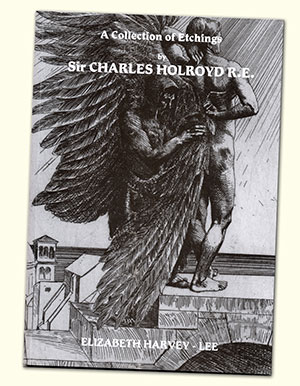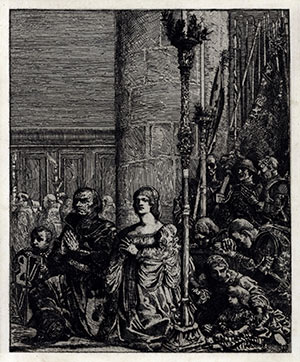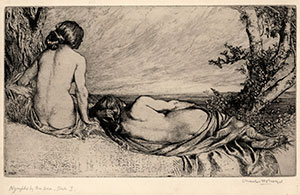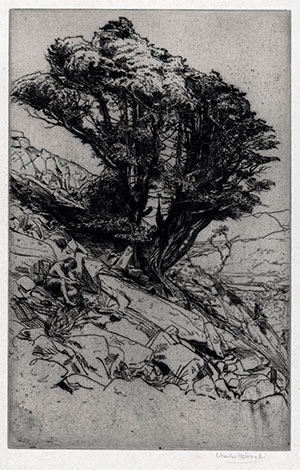|
A Collection of Etchings
by
Sir CHARLES HOLROYD R.E.
A paper catalogue of the web exhibition, augmented by an additional six subjects of different provenance.
Holroyd’s etchings, though he produced some 286 plates, rarely come on to the market, so that today he is relatively little known as an etcher.
It is therefore a welcome opportunity to offer this selection of seventy-eight subjects that come directly from the artist, descending via his wife Lady Holroyd, to their son Michael, who having no children left them to his godson and his godson’s wife.
Further they give a very good representative cross section of his œuvre, from his earliest plates through to the penultimate year of his life.
They comprise examples from two of his main series, Icarus and Monte Oliveto Maggiore as well as independent mythological and religious images, unusual themes for the period, and as the years passed, his move into ‘conventional’ landscape and topographical subjects, more typical of Modern British etching.
They reveal his love of trees, of Italy and of the Lake District.
Holroyd was born in Potternewton, Leeds in 1861 and on leaving Leeds Grammar School, initially studied mining engineering at the Yorkshire College of Science, but after a year or so changed direction and moved to London in 1880 to attend the Slade, the art school of London University, where he was taught etching by Alphonse Legros.
When he graduated, in 1884, Legros asked him to stay on as his assistant.
Legros considered the traditional journey to Italy such an important part of art training that he donated part of his income to augment the funds available at the college for traveling scholarships.
And a travelling scholarship would allow Holroyd to spend 1889-1891 in Rome, which had a lasting effect on both his work (in its subject matter) and future life; for in Rome he met the Australian artist Fannie Featherstonehaugh Macpherson, daughter of the Premier of Victoria, who, coincidentally had also also trained at the Slade. They returned to England in 1891 and married.
Portrait of Sir Charles Holroyd by Fannie, Lady Holroyd.
Oils, c1900-1905. Exhibited at the Royal Academy 1909.
(Reproduced in Women Painters of the World by Walter Shaw Sparrow, published 1905)
Holroyd was a painter, etcher, author (of Michael Angelo Buonarotti, London, Duckworth 1903, published the year he was knighted) and from 1897 onwards, a museum director. That year he was appointed first Keeper of the new National Gallery of British Art, at Millbank, which became the Tate, the building having been funded by Sir George Tate and having benefitted from the bequest of his art collection.
Holroyd left the Tate in 1906 to become Director of the National Gallery. There, under his directorship notable acquisitions included The Rokeby Venus by Velasquez, Masaccio’s Virgin & Child, Raphael’s Procession to Calvary, Cranach’s Charity and Vermeer’s Young Woman seated at a Virginal.
However, his own painting, and particularly his etching, continued to engage Holroyd, but was necessarily confined to his spare time and holidays.
Elected to the Royal Society of Painter-Etchers in 1885 Holroyd exhibited new etchings every year (with only three exceptions 1888, 1890 & 1915) at the R.E. for thirty years, from 1885 through to 1916.
He also exhibited paintings, mainly in oils, at the Royal Academy from 1885 until 1917, and in 1906
exhibited two etchings, the only year he showed etchings at the R.A.
Though Holroyd was a member of the International Society of Sculptors, Painters and Gravers, he only exhibited with them once, a painting, in 1913.
He was also a member of the Art Workers’ Guild, and elected Master for the year 1905.
The majority of Holroyd’s actual etching plates, some worked on both sides, are today housed in the Ashmolean.
Holroyd gave each of his prints an opus number, but in five instances where he reworked a plate at a later date he gave the later state a new opus number. Campbell Dodgson, when he compiled the catalogue of Holroyd’s etchings for Print Collector’s Quarterly in 1923, compacted Holroyd’s numbering, including the later state of the plate with the original one, amalgamating both under the earlier single catalogue number. Hence the occurrence of apparent reference number discrepancies.
La bella Romana
Dodgson 45
(Holroyd Opus 45) 200 x 150 mm
Original etching and drypoint, 1891.
Two impressions in different states.
One initialled in pencil,
one signed in full, tipped at the top two corners
to a backing board,
which has been annotated on the reverse Lady Holroyd, a portrait.
Both on cream laid, though different, papers.
£400
A portrait of the artist's wife.
Published December 2022.
A5 (210 x 147 mm) ; 56 pages, with 108 illustrations, 3 in colour.
84 items for sale.
(UK price: £10, International orders: £13)
Prints available
Prints from this catalogue are still available for purchase.
^ Return to the top of this page ^ |
|

The front cover of the catalogue shows Daedalus & Icarus, second plate of the Icarus Series.
Details can be viewed in the online exhibition here: Daedalus & Icarus.
A selection of prints
from the catalogue:

Colleoni at the Frari:
A Thanksgiving for Peace
Dodgson 163 i/ii (Holroyd Opus 168).
251 x 202 mm (plate),
224 x 184 mm (image).
Original etching, 1902-03.
The plate signed.
Probably first state of two, the foot at the bottom right ‘white’.
Signed in pencil.
£150
Exhibited at the R.E. 1903
The famous Venetian condottiere after the Venetian victory over Milan.

Nymphs by the Sea
Dodgson 184 i/ii (Holroyd 189)
175 x 302 mm
Original etching, 1904-05.
First state of two.
Signed in pencil, entitled and annotated
State I.
£550
Details can be viewed in the online exhibition here: Nymphs by the Sea.

A Yew Tree on Glaramara
Dodgson 169 (Holroyd Opus 174 )
355 x 228 mm
Original etching, 1902-03.
Signed in pencil.
£200
Exhibited at the R.E. 1903
A view in Borrowdale.
Holroyd was particularly fond of yew trees and was inspired by Wordsworth’s poem about yew trees in Borrowdale.
Holroyd greatly enjoyed walking in the Lake District and all of his Lakeland subjects are places only reachable on foot.

Subiaco in the Sabines
Dodgson 276 (Holroyd 281)
251 x 353 mm
Original etching, 1913-14.
Signed in pencil and entitled Subiaco.
£400
A dramatic view of the hilltown, dominated by the Rocca Abaziali fortress.
Exhibited at the R.E. 1914.
Details can be viewed in the online exhibition here: Subiaco in the Sabines.
Return to the top ^ |